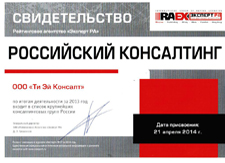НАША МИССИЯ
Мы содействуем становлению и развитию финансового сектора в странах Восточной Европы и СНГ, помогаем финансовым институтам добиться успеха, стабильности и процветания.
Контакты:
- — Россия
- — Великобритания
- — Беларусь
- — Украина
Целесообразность каждого из них необходимо оценивать сугубо с учетом поставленных задач, текущего состояния действующего бизнес-процесса, уровня квалификации персонала, уровня занятости основных специалистов и т.д. Положительные примеры реализации проекта есть как по любой из перечисленных форм сотрудничества с консультационными компаниями,
Title
There is an inadequate idea spread among some potential consumers of consulting services of what consultants can actually provide, when it makes sense to address them and what are prerequisites for successful co-operation with consultants. And whether it is worth to address them at all?
Even if you believe that your company is good as it is, who knows, maybe, the things could be much better? And what will happen tomorrow?
Those who've managed to reach the top (professional or otherwise), will know that although to get there is hard, it is much more difficult to resist and do not slide down.
First of all, consultants assist clients in solving their management problems. They can solve this problem in several ways:
- Find the problem and propose solutions. In situations where the client is aware that he has a problem but cannot determine what exactly it is, what its true reasons is, consultants can analyze the situation and identify the problem and its causes, develop a solution and offer it to the client. This is the so-called expert advice when consultants themselves do all the work to identify and solve the problem.
- Help the client to find the problem and identify ways to address it. There are times when the client is ready to identify the problem and solve it, but he lacks some of the methodological support for the successful implementation of his intentions. Then the consultant can provide methodological support for this client and go along with him all the way from discovering the problem to its solution. This approach is called process consulting, i.e. counselling during the process of the client’s management activity.
- Teach the client to identify and solve problems. Creating a system of practical knowledge with a customer, a mechanism allowing him henceforth to find and solve his problems is the essence of the third approach, called training consulting. In this approach, the consultant is not directly involved in the process of finding and solving problems and only teaches the client and checks the “Homework” results.
“The only type of work that is worthy of a consultant is the work that teaches clients and their staff to manage themselves better” said Lyndon Urvik, one of the main developers of the management consulting theory.
This point is given much attention to in the modern sense of advice. Many customers are turning to consultants not to find a solution to a particular problem, but to acquire specific technical knowledge of the consultant (for example, in analysis of the situation or economic conditions forecast) and master the techniques the consultant applies in identifying problems and implementing changes (survey, diagnostics, communication, persuasion, feedback, evaluation and other techniques).
The learning process as a part of the consulting activities requires certain effort from both the trainer and the trainee. The process of implementation of what was learned is ever more impossible by consultants only. Implementation is a joint activity.
The following advantages of addressing a consultant can be outlined in relation to the internal staff and managers:
- He is an independent expert, he is not an employee of your organization, hence the results of his works are objective
- As an external consultant working in many organizations he has experience in solving problems in these organizations and it is easier for him to diagnose the problem, find ways to solve it than for the manager or the internal consultant,
- A consultant’s opinion is always an outside point of view, which is very useful for understanding the problems in the organization,
- Consultant continuously learns and controls all the information in his area and runs around with other consultants of the firm obtaining their knowledge and experience,
- Intensive professional assistance on a temporary basis,
- Motivation of his activity is higher than that of the internal worker, as his remuneration as well as access to internships and training programs, distribution of profits and the opportunity to become a partner of the company is directly dependent on the quality of the work fulfilled and his professional level.
Basic principles and methods of consultant’s operation in a client’s organization:
- Maintain complete confidentiality in respect to the information received from the client
- Maintain with the client an atmosphere of cooperation, based on mutual trust.
- Abandon the project in lack of confidence in its success
- Do not give advice or take any actions that are inconsistent with the law
- Honestly and timely inform the client of any risk or obstacle (such as a conflict of interest) during the project
- To promote above principles to all third-party companies and individuals involved in projects implementation
NEWS
7 September 2022
The programme to strengthen Azerbaijani financial institutions, funded by the European Bank of Reconstruction and Development (EBRD), the European Union and Türkiye, successfully completed.
more »15 January 2020
TA Consult starts implementation of Uzbekistan: Food Safety Review Project
more »4 January 2020
TA Consult starts implementation of Diagnostics Project with Moldova Agroindbank (MAIB)
more »









